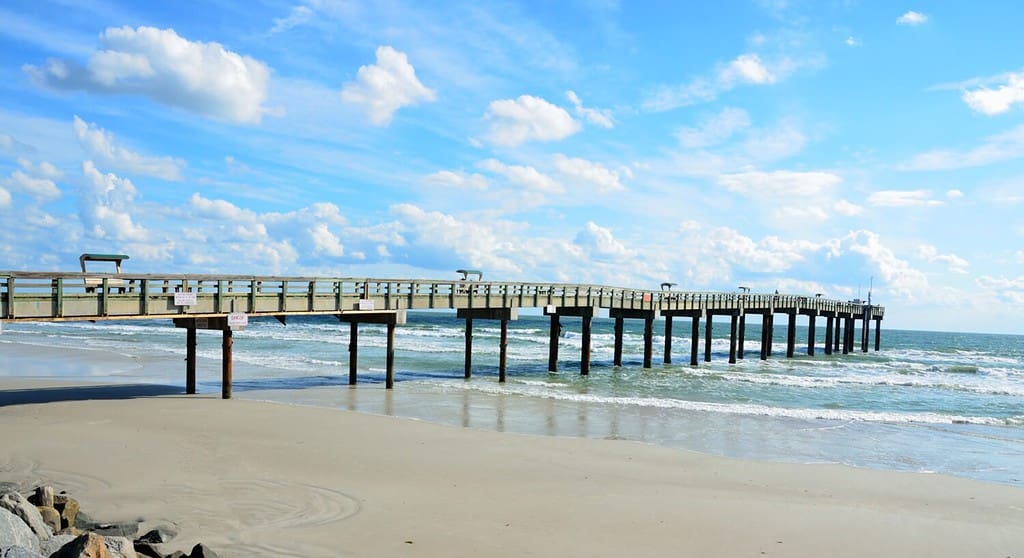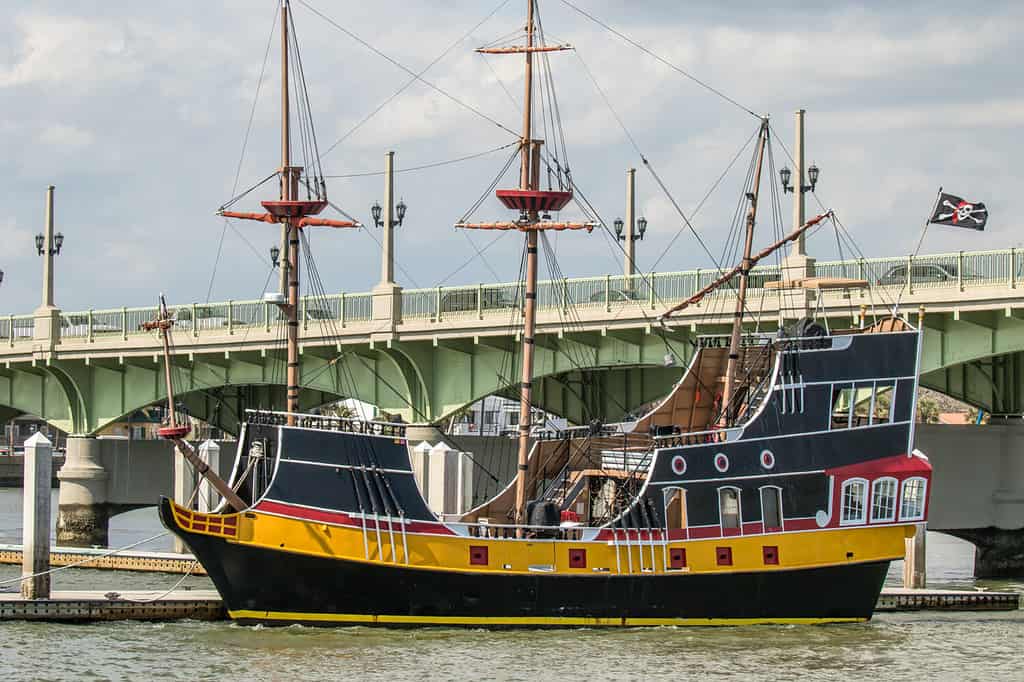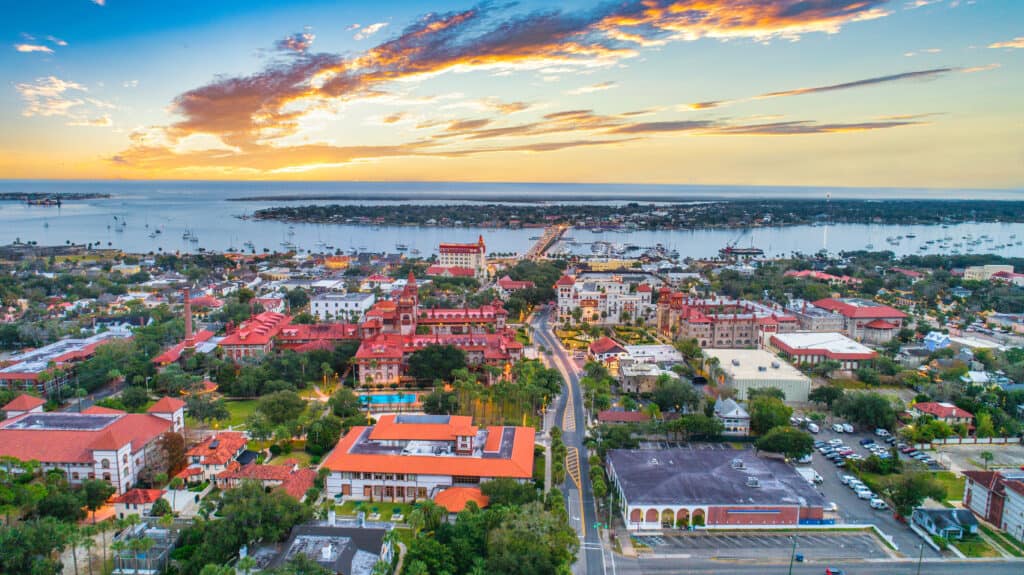Saint Augustine is a quirky little town in north Florida with a rich history of pirates and plenty of treasure. It’s just 40 miles south of downtown Jacksonville, situated on the Atlantic Ocean. The city has been around for over 450 years and has been continuously inhabited since its establishment.

Where Is St. Augustine Located on a Map?
St. Augustine is in the northeastern part of Florida. It’s about an hour south of Jacksonville and about three hours from Orlando. It’s situated directly on the Tolomato and Matanzas Rivers. You can reach St. Augustine by taking Highway 1, which runs directly through the city.
When Was Florida Discovered?
St. Augustine may be Florida’s oldest town, but Florida was discovered just a bit earlier than that specific area. Juan Ponce de Leon is credited with discovering the land in 1513 in the early month of April. Historians believe that Ponce de Leon stumbled onshore around the same area as St. Augustine would later be formed.

St. Augustine is a beach town in northeast Florida.
©Paul Brennan/Shutterstock.com
When Ponce de Leon set out on his journey, he certainly wasn’t looking for the New World. He was searching for the “Fountain of Youth.” The fountain was a fabled water source that was rumored to bring eternal youth to any who drank from or waded in its waters.
Ponce de Leon is credited with naming the state “La Florida.” He discovered the land during the Easter feast, or Pascua Florida, and claimed the newly named area for the crown of Spain.
Ponce de Leon continued his expeditions to Florida, returning again eight years later in 1521. The second expedition was set in an attempt to establish a Spanish colony in the area. This time, the Native Americans who lived in the area were prepared for his arrival. They attacked his expedition and mortally wounded Ponce de Leon. After this attack, the Spaniards retreated back to Cuba, where Ponce de Leon died of his wounds.
Early History
Since it’s the oldest town in Florida, it shouldn’t be surprising that St. Augustine has a rich history. It was founded on September 8, 1565, by Pedro Menendez, a Spanish explorer who eventually became Florida’s first governor.
Menendez began his journey in 1560 when King Phillip II of Spain appointed him as Captain General of the Fleet of the Indies. He commanded the Spanish Treasure Fleet for a few years, leading voyages to the Caribbean and Mexico before requesting to make the trip to Florida. His request was repeatedly refused for a while, but later the idea was brought up again, this time at the request of the crown.
The crown had learned that the French Huguenots had succeeded in establishing a colony in Florida by the St. Johns River in 1564. Just one year later, the crown allowed Menendez to make the voyage to Florida under the condition that he would settle the area under Spanish rule. He would also be required to eradicate the colony that the French had established.

Menendez was a Spanish explorer who became the first governor of Florida.
©Bob Pool/Shutterstock.com
Naming a New Land
Menendez and his crew sighted land on August 28, 1565. This was the feast day of St. Augustine of Hippo. Because the sailors saw the land on that day, they decided they would call it St. Augustine. Before reaching the shore, they turned north and sailed alongside the shore to investigate the rest of the area. They were looking for smoke plumes and any movement on the shores to give them information on their enemy’s whereabouts.
On September 4, 1565, they spotted movement and encountered four French vessels. The fleets met and had a brief spat, but it ended without a clear victory. After this encounter, they turned south and began sailing back toward the land they had first spotted.
Finally, on September 8, they reached the shore, and Menendez formally founded the area of St. Augustine.
First Residents
Once Menendez and his crew reached land, they got to work quickly. They served the crown’s demands and eradicated the French garrison. They established a community in St. Augustine that would serve two purposes. It would be a military outpost, perfectly situated on the water to defend Florida from other interested countries. It would also serve as a base for the Catholic mission, Mission Nombre de Dios.
Some of the first residents that the party met were the Timucuan people. The Timucuans welcomed them and offered them their own homes and villages. For a few months, the Timucuans and Spanish populations cohabited for the first time in recorded history. The area where this settlement was is now preserved at the Fountain of Youth Park. It contains artifacts and historical records of what life was like in the small village.
Unfortunately, this time of peace between the two populations did not last long. Disease, which was brought by the Spaniards, quickly spread to the native people and killed off most of their population.
After this, there were a few more attempts by the French to attack St. Augustine and take the land. One attempt was stopped by a squall that destroyed almost all of the French vessels, leaving a crew of 20 soldiers and 100 others. Menendez saw this chance to take advantage and marched to the St. Johns River with his troops. They easily overtook the small French garrison, sparing only the women and children. Menendez renamed the French fort and claimed it under Spanish rule under the name San Mateo.

The Gonzalez-Alvarez house in St. Augustine is a National Historic Landmark.
Pirate Problems and Other Enemies
For a while, there was peace in St. Augustine. The local Spaniards and Native Americans had learned to coexist without strife. But in 1586, during the heat of the Anglo-Spanish war, English privateer Sir Francis Drake attacked St. Augustine and forced Menendez and the other townspeople to evacuate. Drake burned the town to the ground and pillaged any treasure he could find. Eventually, the Spanish returned and began rebuilding. They then used their location as a military base to send out expeditions against the English colony at Jamestown.
In 1668, Spanish supply vessels were attacked and held at gunpoint by the English buccaneer Robert Searle. He killed sixty people and pillaged the town of St. Augustine. This attack convinced the crown, Queen Regent Mariana, to use funds for constructing a fortress around the town. Construction began in 1672 and was completed in 1695, and the fortress was named the Castillo de San Marcos.
The fort was attacked seven years later by James Moore, who was governor of Carolina at the time. Moore’s forces sieged the fort for 58 days but were unable to capture it. Again, the town of St. Augustine was set ablaze, this time by Moore’s forces. Another attempt to take the fort occurred in 1740, led by General James Oglethorpe, governor of Georgia. This attempt was also unsuccessful.
The Treaty of Paris
When Great Britain won the Seven Years’ War, claiming victory over Spain and France, they signed a treaty called the Treaty of Paris. The treaty of 1763 ceded Florida to Great Britain in exchange for returning Havana and Manila to Spain. The Spanish evacuated to Cuba along with the small remaining population of Timucuan people.
When the Spanish left, Great Britain knew it needed to repopulate the colony. The Board of Trade advertised large lot spaces of 20,000-acre lots to groups who wanted to settle in Florida. Each resident would be granted 100 acres or more, depending on their character and reputation. Many British citizens took the offer, and soon the territory of Florida was full of new citizens.
The second treaty, the 1783 Treaty of Paris, recognized the independence of the Thirteen Colonies as the United States. It also ceded Florida back to Spain, exchanging the Bahamas back to Britain.

St. Augustine was repopulated by Great Britain after the Spanish citizens fled the area.
©Kevin Ruck/Shutterstock.com
Spanish Rule
The town was once again under Spanish rule, and many of the residents who left in 1763 returned again. During this time, Spain was facing attacks from Napoleon and his French forces, which left the country in a poor economic state. In 1811, St. Augustine was ravaged by a strong hurricane that caused a lot of damage. When the Adams-Onis Treaty was negotiated and ratified in 1821, it made sense for the Spanish to release Florida and St. Augustine to be owned by the United States.
Florida in Modern Times
After the treaty was signed, the U.S. paid Spain $5 million and Spain renounced its claim to the land. Americans from other colonies moved to Florida, and the capital moved from St. Augustine to Tallahassee. So many new residents brought new conflicts, especially between the native tribes of Creek and Miccosukee peoples and the Americans. There were three Seminole wars in the 19th century. By mid-century, the population of Florida was over 50,000, and it was admitted to the Union as a state in 1845.
The town celebrated its 450th anniversary in 2015 and received visits from Felipe VI and Queen Letizia of Spain. A year later, it was nearly destroyed by Hurricane Matthew, which caused flooding throughout the downtown. It has since been rebuilt and continues to thrive.

St. Augustine was flooded during Hurricane Matthew, but it has since been rebuilt.
©pisaphotography/Shutterstock.com
Things To Do in Florida’s Oldest Town
One of the best things about St. Augustine is that there’s something to do for everyone. You can visit Ponce de Leon’s Fountain of Youth Archaeological Park to learn about the early habitation of the Spaniards and Timucuan people. Visit the St. Augustine Pirate and Treasure Museum to see real artifacts that have been found from pirates in the area. Or visit the beach and look for birds in Anastasia State Park.
Wildlife You’ll Find in St. Augustine

Wood storks live by a retention pond on Route 312 in Anastasia State Park.
©Breck P Kent/Shutterstock.com
St. Augustine has a wide variety of wildlife because it encompasses an area of land, brackish water, and salt water. Anastasia State Park is one of the best spots for bird watchers. You can spot wood storks, a threatened species that lives by the retention pond on Route 312. Roseate spoonbills, a bright pink bird, also like this area. If you like parrots, you can spot flocks of Monk’s parrots flying along A1A. You’ll also be able to hear these loud, squawking birds from a distance, as they always sound like they’re arguing while they fly.
Another animal that lives on the coastline is the sea turtle. They build their nests on the beaches, which you can identify by the bright-colored tape and stakes. The tape and stakes are used to mark the area and protect the nests.
Travel along the Tolomato and Matanzas rivers, and you’re sure to spot a pod of dolphins. You can also see manatees, crabs, and fish like snapper and snook.
The photo featured at the top of this post is © Barbara Smyers/Shutterstock.com
Thank you for reading! Have some feedback for us? Contact the AZ Animals editorial team.







